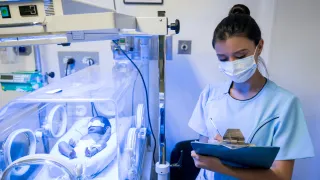
Welcome to Amanda's NICU Education




Hi! My name is Amanda. I'm a NICU nurse, Clinical Nurse Specialist, NICU Educator... basically your NICU BFF. If you want to talk NICU, I'm here for you! I love everything about NICU nursing and I'm eager to learn and share my knowledge with all my NICU friends.
I have been a NICU nurse since 2009 I am currently a Clinical Nurse Specialist in a Level IV NICU in Los Angeles.
I am passionate about educating the next generation of NICU nurses. I share my knowledge through platforms such as Instagram and Facebook and am excited to have you here on my website!
Click on the button below to sign up for my newsletter filled with NICU education and tips for all experience levels.

Not very many people love taking tests but as a self-acclaimed "forever student" who has taken (and passed) five different certification exams I am no longer afraid of tests! "Way to brag", you might be thinking but I want to help YOU pass your certification exam too!
Introducing Amanda's RNC-NIC Success digital course - your ultimate study companion!
Gain unlimited, on-demand access for life, ensuring you're primed to ace your certification exam.
I'm here to help you succeed and I can't wait for you to share with me that you PASSED the RNC-NIC EXAM!!!










ANC & I/T Ratio
Each component of a CBC has a unique story to tell, and putting them all together helps us provide the best care possible
Do you ever feel confused by lab values?
I struggled with lab values for a long time. Whether it was blood gas interpretation, evaluating a CBC with differential, or knowing when the glucose is considered low or normal (although glucose is still a hot topic). I was confused but after a lot of practice, patience, studying, and hardwiring I finally get it and I want to help you too!
Before we calculate the ANC and I/T ratios, let's briefly review the components of the CBC.
1. White Blood Cells (WBC):
Think of WBC as the little warriors in our bloodstream. They're the defenders, fighting off infections and keeping our babies safe. When we see an increase in WBC count, it's like calling in reinforcements to tackle those pesky infections. On the other hand, a decrease in WBC count may mean we need to watch out for potential immune system challenges. There are many types of WBC, particularly the neutrophils who I like to think of as the soldiers who are the first to go out for battle. The different types of WBCs are displayed as percentages in the differential when a Doctor (or Nurse Practitioner or Physicians Assistant) orders a CBC with differential.
2. Hemoglobin (Hgb):
Hemoglobin is like the delivery team for oxygen. It carries those precious O2 molecules to every nook and cranny of the body. When we see healthy Hb levels, it's like our little ones are getting their own personal oxygen delivery service. But if Hb levels drop, it's time to investigate possible anemia issues. Anemia is a common issue we see in our premature patients.
3. Hematocrit (Hct):
Hct is the measurement of the percentage of red blood cells in the blood. The red blood cells carry hemoglobin in order to deliver oxygen to the tissues. A high Hct means our little patients have plenty of red blood cells, while a low Hct might signal a need for further investigation.
4. Platelets (Plt):
Platelets are like the superheroes of clotting. When there's a cut or a tiny injury, the platelets rush in to stop the bleeding and start the healing process. If we spot low platelet levels, it's time to be on the lookout for potential bleeding issues and infection.
5. Mean Corpuscular Volume (MCV):
MCV is like the size-o-meter for red blood cells. It tells us if the red blood cells are the right size or if they might be having a growth spurt. Too large or too small might signal underlying conditions we need to address.
6. Absolute Neutrophil Count (ANC):
The ANC tells us the total number of neutrophils the baby has. I like to think of this as giving us a gauge of the size of our army (with each neutrophil being one soldier). These warriors are our first responders against infections. A healthy ANC means our soldiers are ready to take on anything that comes their way!
We calculate the ANC by adding up the total number of neutrophils. The names we may see in the differential include polys, neuts, PMNs, segs, bands, metas, and stabs. After we add up the total number of neutrophils we multiply that number (as a percentage) by the WBC. That will tell us the total number of neutrophils aka the ANC.
7. Immature to Total (I/T) Ratio:
The I/T Ratio tells us a percentage of how many of the circulating neutrophils are immature. Continuing with the soldier analogy, I like to think of the immature neutrophils (bands, metas, and stabs) as soldiers that haven't finished boot camp yet. When we add up all the immature neutrophils and divide that by the total number of neutrophils that gives us an idea of how strong our army is. If more than 20% of our army is immature that is considered a "left shift". In conjunction with the patient's clinical assessment, we worry about the presence of infection when we see a left shift.
Remember, interpreting the CBC is like deciphering a message from our little patients' bodies. Each component has a unique story to tell, and putting them all together helps us provide the best care possible. Also always keep in mind that a lab value is only a moment in time. Look at that information in conjunction with your clinical assessment.
I have a whole section on the immune system, neonatal sepsis, lab interpretation, and congenital viral infections in my upcoming RNC course. It will be available this Fall! Join my waitlist by clicking the button below.
You're all doing an incredible job caring for these tiny warriors. Keep rocking that NICU world!
With tons of admiration and gratitude,
Amanda xoxo

December 2023 Certification Review Webinar
NICU Certification Review



Ready to kickstart your journey to becoming a certified NICU nurse?
Look no further!
Grab my FREE E-Book packed with essential study and test-taking strategies for the RNC-NIC.
In the E-Book I give you the resources you need including the link to access the candidate guide, several types of books to study from, some of my favorite strategies, an outline of the content you should review, and a blank calendar for you to make your study plan!
Frequently Asked Questions About the RNC-NIC exam

What is the RNC-NIC?
The RNC-NIC is a competency-based exam that tests the specialty knowledge of nurses in the United States & Canada who care for critically ill newborns and their families.
The RNC-NICU is a nationally recognized certification that recognizes the registered nurse for their specialty knowledge and skill.

Who can take the RNC-NIC exam?
Nurses can take this exam after a minimum of two years experience in the NICU caring for critically ill newborns and their families.

Which books should I use?
I'm glad you asked! There are many excellent books to help you prepare for the RNC-NIC, I gathered ande describe each of them for you in my FREE e-book.
Is there a course to help me study?
Yes! Many hospitals host their own certification course and there are a few online courses. See my RNC-NIC test taking tips E Book for more information
What happens if I don't pass the exam?
If you don't pass the exam on your first try you can try again after 90 days. You will have to reapply after 90 days and pay a retest fee. There is no limit to the number of times you can take the exam (however a candidate can only sit for the exam twice per year).

Can I make more money if I take the RNC-NIC exam and get certified?
Yes! Many hospitals provide a raise or a bonus for nurses with specialty certifications. Hospitals also typically hire at a higher base salary when nurses have a certification.

Find me @amandasnicued on these channels or Email me
hey nurses don't miss out
© Copyright 2024. AmandasNICUEd. All rights reserved. | Terms & Conditions | Privacy Policy Contact: [email protected]

